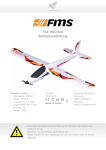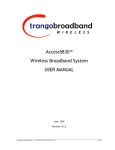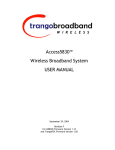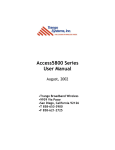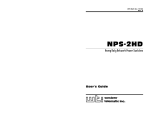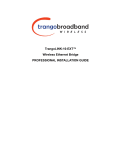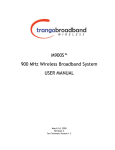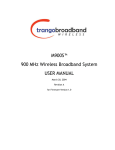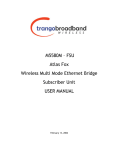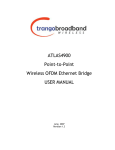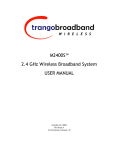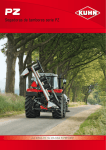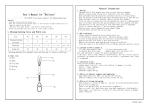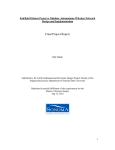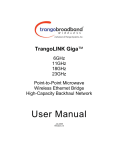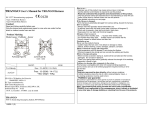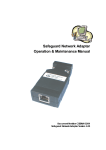Download TrangoFOX™ Subscriber Unit User Manual
Transcript
TrangoFOX™ Subscriber Unit (for Access5830™ Wireless Broadband System) User Manual TrangoFOX™ Subscriber Unit User Manual Overview This manual covers basic configuration and installation of TrangoFOX Subscriber Units for the Access5830 Wireless Broadband System. The FOX series subscriber units are available three variations. Model FOX5800 FOX5300 FOX5800-D Part # M5800S-FSU M5300S-FSU M5800S-FSU-D Description __________ 5.8 GHz FOX SU with internal 15 dBi antenna 5.3 GHz FOX SU with internal 15 dBi antenna 5.8 GHz FOX SU for Reflector Dish Part# AD5800-25 TrangoFOX subscriber units work in conjunction with 5.8/5.3 GHz dual-band Access5830™ access points. The FOX5800 and FOX5800-D also work in conjunction with 5.8 GHz single -band Access5800™ access points. Please refer to the Access5830 (or Access5800) user manual for detailed information on overall system implementation, configuration, and management of your point-to-multipoint system. The Access5830 User Manual also covers many important details of subscriber unit configuration. FCC Information This device complies with Part 15 of FCC Rules and Regulations. Operation is subject to the following two conditions: (1) This device may not cause harmful interference and (2) this device must accept any interference received, including interference that may cause undesired operation. This equipment has been tested and found to comply with the limits for a Class B digital device, pursuant to Part 15 of the FCC Rules. These limits are designed to provide reasonable protection against harmful interference in a residential installation. This equipment generates, uses, and can radiate radio-frequency energy and, if not installed and used in accordance with these instructions, may cause harmful interference to radio communications. However, there is no guarantee that interference will not occur in any particular installation. If this equipment does cause harmful interference to radio or television reception, which can be determined by turning the equipment off and on, the user is encouraged to correct the interference by one of more of the following measures: 1) 2) 3) 4) Reorient the antenna; Increase the separation between the affected equipment and the unit; Connect the affected equipment to a power outlet on a different circuit from that which the receiver is connected to; Consult the dealer and/or experienced radio/TV technician for help. FCC ID: NCYM5800SFSU NCYM5800SFSUD NCYM5300SFSU Canada: to be announced soon IMPORTANT NOTE: Intentional or unintentional changes or modifications must not be made unless under the express consent of the party responsible for compliance. Any such modifications could void the user’s authority to operate the equipment and will void the manufacturer’s warranty. To comply with FCC RF exposure requirements, the following antenna installation and device operating configurations must be satisfied. The antenna for this unit must be fixed and mounted on outdoor permanent structures with a separation distance of at least two meters from all persons. Furthermore, it must not be co-located or operating in conjunction with any other antenna or transmitter. Trango Broadband Wireless Page 2 TrangoFOX™ Subscriber Unit User Manual Warranty Information TrangoFOX Subscriber units are provided with a limited 1 year warranty from date of purchase. Please see www.trangobroadband.com for complete description of warranty coverage and limitations. Trango Broadband Wireless Page 3 TrangoFOX™ Subscriber Unit User Manual Getting to Know Your Radio Contents Each TrangoFOX subscriber unit comes equipped with the radio itself, a power-over-Ethernet (PoE) J-Box, an AC adapter, and mounting hardware. The FOX5800 and FOX5300 include hardware for wall or pole mounting (except for wall mount screws and pole-mount hose clamps which are not included). The FOX5800-D is equipped with a dish (reflector) mounting bracket. Figure 1. Components of TrangoFOX Subscriber Unit MOUNTING HARDWARE (FOX5300 & FOX5800) POWER SUPPLY (120 VAC - 20 VDC) - BRACKET, STANDARD - EXTENDER - (2) 1/4-20 HARDWARE DISH MOUNTING HARDWARE (FOX5800-D ONLY) RADIO J BOX (POWER OVER ETHERNET INJECTOR) - BRACKET, REFLECTOR - 10-32 X 1" HARDWARE - 1/4-20 HARDWARE The radio’s model number and FCC ID are located on the side of the radio. Figure 2. Radio Side View TRANGO BROADBAND WIRELESS M5800S-FSU FOX5800 (TM) REV A FCC ID: NCYM5800SFSUD CANADA: XXXXXXXXXX Trango Broadband Wireless Page 4 TrangoFOX™ Subscriber Unit User Manual The TrangoFOX radio is equipped with a removable “boot” and weatherproofing foam insert. Removing the boot and foam insert reveals the radio’s Ethernet port, LED status lights, reset button, MAC address, and serial number. Figure 3. Exploded View of Radio, Foam Insert, and Boot FOX RADIO FOAM INSERT BOOT Figure 4. Bottom View (Boot Removed) M5300S-FSU MAC: S/N: 0001DE FF FF FF XXXXXXXXXX ||||||||||| ||||||||||| ||||||||||| TEST DATE: Trango Broadband Wireless XX-XX-XX Page 5 TrangoFOX™ Subscriber Unit User Manual Getting Started It is recommended to first provision and test the radio on the bench before deploying in the field. This is a particularly useful exercise to the novice user. Connections and Power ?? Remove the “boot” and foam insert from the bottom of the radio. ?? Connect a Cat-5 (straight through) Ethernet cable (we recommend shielded twisted pair) between the ODU (out door unit) port of the J-box and the RJ-45 connector on the radio. Note that this cable will carry power over Ethernet (PoE). ?? If connecting to a COMPUTER, use a Cross-Over Ethernet cable from the NET port of the J-box to the computer’s Ethernet port. If connecting to a HUB, SWITCH, or ROUTER, use a Straight-Thru cable. ?? Plug the AC adapter into an AC outlet. Figure 5. Wiring Diagram FOX RADIO NETWORK OR COMPUTER INDICATES POWER TO RADIO INDICATES POWER TO J BOX CAT-5 USE STRAIGHT-THRU CABLE IF TO HUB, SWITCH OR ROUTER CAT-5 STRAIGHT-THRU CABLE USE CROSS-OVER CABLE IF TO COMPUTER AC POWER 20 VOLT POWER SUPPLY POWER OVER ETHERNET J BOX Once the radio is powered, check the LED lights on the bottom of the unit for status information. If the unit is powered, and not associated with an AP, the ASSOC light should be blinking. The NET LED will light if the unit is connected to a 100 Base-T Network. Trango Broadband Wireless Page 6 TrangoFOX™ Subscriber Unit User Manual Figure 6. Radio LEDs and Reset Button M5300S-FSU MAC: S/N: 0001DE FF FF FF XXXXXXXXXX ||||||||||| ||||||||||| ||||||||||| ||||||||||| TEST DATE: XX-XX-XX ACT NET – RSSI – LED Guide Indicates Ethernet Receive/Transmit activity. This LED lights when connected to a 100 BaseT network. The LED remains unlit when connected to a 10 BaseT network Relative Signal Strength Indicator. See Antenna Alignment section for more details. ASSOC – This LED indicates one of four statuses: 1. Off - when there is no power at the radio. RESET BUTTON Pressing the Reset Button (while the unit is powered) will restore the radio’s factory default IP address and password. The Reset Button does NOT reset any other parameters. 2. Blinks once every second - unit is powered on but opmode is OFF. 3. Blinks twice per second - unit is in opmode SU and scanning for an AP 4. Solid On - unit is associated with an AP.. Basic Configuration The TrangoFOX can be configured using either the Command Line Interface (CLI) or the Web Browser (HTTP) interface. This manual covers the basic HTTP screens from the radio’s built in web server. For a more comprehensive description of the provisioning and management tools, as well as the complete command line interface reference guide, please see the Access5830 User Manual. NOTE: The screenshots presented in this manual are from the FOX5800. Similar screenshots are available on the FOX5300 and FOX5800-D Browser Interface The Web browser interface is a powerful and easy-to-use configuration and management tool. Its functionality is a subset of the commands available in the CLI. To use the browser interface – you must have the following: ?? An Ethernet connection between a PC and the radio ?? Setup your Ethernet PC connection to the subnet that is routable to the radio (default IP address=192.168.100.100) ?? A web browser (i.e. Microsoft Internet Explorer) In order to use the browser interface – simply connect the radio to a PC, and type the radio’s IP address into the web browser (i.e. Microsoft Internet Explorer). This will bring up a logon page. Trango Broadband Wireless Page 7 TrangoFOX™ Subscriber Unit User Manual Current Status information is provided in the lower left-hand corner of on all screens. The Current Status shows Base ID, AP ID, SU ID, Current Opmode, Current Channel and polarization, and its RF link status to the AP(Connected or Disconnected). Type the password (default trango) and continue. This will bring up the radio’s system information page. System Information The Browser Interface features useful Help pages which explain all listed parameters. To access the help pages click on the Help link. Hardware Version: Hardware version (Fox5300 is 0003; Fox5800 and FOX800-D is 0004). This parameter is set by the factory and cannot be altered by the user. FPGA Version: Field-Programmable Gate Array (FPGA) firmware version. This version will change in the event that new FPGA version is loaded into the radio. Trango Broadband Wireless Page 8 TrangoFOX™ Subscriber Unit User Manual Firmware Version: Main firmware version. This version will change in the event that new firmware is loaded in the radio. Checksum: Firmware checksum is comprised of FPGA firmware and main firmware. Each firmware release has its own specific checksum provided by manufacturer. Checksum which does not match the number provided by manufacturer indicates corrupt firmware. DEVICE ID: MAC address of the radio. Base ID: See definition in Configuration section. AP ID: See definition in Configuration section. SU ID: See definition in Configuration section. Opmode: Current operation mode of the radio. "SU" indicates transmitting. "OFF" indicates not transmitting. Default Opmode: See definition in Configuration section. System Up Time: Time since radio was last rebooted. IP Address, Subnet Mask and Gateway: See definition in Configuration section. Telnet Port: User changeable telnet port of radio. Tftpd: Current status of TFTP daemon. Used for uploading firmware. Active Channel: See definition in Configuration section. RF Rx Threshold: See definition in Configuration section. Tx Power: Current power output of the radio at the antenna port (in dBm). This parameter varies as directed by the Access Point as a result of AP command “su powerleveling”. Channel Table (MHz): Shows correlation between channel number and assigned center frequency. Table allows 30 entries. User can make changes to this table under Advanced Setup section. Default table includes channels in both ISM and U-NII band. Note: lined-out frequencies are not available on this radio. Scan AP Sequence: See definition of this switch setting in Configuration section. Broadcast Packet: See definition of this switch setting in Configuration section. Auto Scanning AP: See definition of this switch setting in Configuration section. TCP/IP Service for AP: See definition of this switch setting in Configuration section. TCP/IP Service for Ethernet port (opmode su): See definition of this switch setting in Configuration section. Remarks: See definition in Configuration section. Trango Broadband Wireless Page 9 TrangoFOX™ Subscriber Unit User Manual Configuration Page Many of the parameters listed on the System Information page can be changed by the user. Click on Configuration page for user changeable parameters. Configuration Page Parameters Base ID: User definable base station ID (1-127); typically assigned to a group of APs at a particular cell site. The Base ID in AP must match the Base ID in SU in order for link to be established. This parameter can only be changed while opmode is "OFF". AP ID: User definable AP ID (1-255). This parameter is for informational purposes only and does not play a role in the link establishment. This parameter can only be changed while opmode is "OFF". SU ID: This parameter is used to uniquely identify the SU within a particular sector. The range is 1-8190. The SUID, along with its priority type, SU to SU group (if active), CIR, MIR, and device ID must be in the AP's subscriber database before a link with the AP is established. This parameter can only be changed while opmode is "OFF". IP Address, Subnet Mask and Gateway: The IP Address, Subnet Mask, and Gateway of this radio for configuration, and network management purposes. Since this is a layer-II device, these parameters do not play a role in the establishment of the wireless link. Default Opmode: Operation mode of the radio after power cycle or reboot. When the radio enters opmode "SU", it will be transmitting. When the radio enters opmode "OFF" the radio is not transmitting, but can be accessible via the Ethernet port. The radio can be put into opmode "OFF" regardless of its default opmode by telneting into the radio or accessing the radio via HTTP within the first 30 seconds after power cycle or reboot. Switches: Checked means active Block Broadcast and multicast packets - Block these types of Ethernet packets when active- ARP and DHCP packets will be passed regardless of this setting. Trango Broadband Wireless Page 10 TrangoFOX™ Subscriber Unit User Manual Auto Scan AP - Active channel and polarization scan sequence below. TCP/IP Service for AP - Allow TCP/IP access into the SU via the RF link when the SU opmode is "SU". TCP/IP Service for Ethernet port (opmode su) - Allow TCP/IP access into the SU via the Ethernet port when the SU opmode is "SU". Scan AP Sequence: The set of channels and antenna polarizations the SU will automatically scan while it searches for an AP. Remarks: A descriptive text field for general use (i.e. the location of the unit). It does not affect system performance. Save and Activate Settings: Saves to memory any settings that were altered. These settings are then activated. Note: All changed settings will revert to previous values on power cycle if Save and Activate is not selected. Activate Opmode: Activates radio's Opmode to "SU"-transmitting. To turn a radio to opmode "OFF", see Default Opmode. Reboot System: Reboots the system. Make sure all settings have been saved first. Advanced Setup Page In order to optimize your wireless link it may be necessary to reassign channels or change the receivers RF Threshold. To access these parameters, click on the Advanced Setup link. Channel Table: Allows user to define a new channel by assigning the center frequency to a specific channel number. RF Rx Threshold: Sets the receive threshold of the radio. The radio will not process signals received below this level, so it is very useful for interference mitigation. Setting the Threshold higher (less negative) raises the level of the noise floor the radio can handle. However, setting the threshold higher will reduce range. Trango Broadband Wireless Page 11 TrangoFOX™ Subscriber Unit User Manual Save and Activate Settings: Saves the setting to FLASH memory and activates setting. Site Survey The TrangoFOX includes a site survey tool for detecting RF interference. To utilize this feature, click on the Site Survey link. The radio must be in Opmode "OFF" in order to use this feature. Enter the number of minutes desired for the survey, and select the polarization. Click "Start Survey". A survey of the default channels (6 for ISM band (FOX5800) and 5 for U-NII band (FOX5300)) will be performed. Results are reported in dBm per channel as average and peak. A channel is reported to be "Clear" if the peak and average are below the RF RX Threshold by more than 8 dB. Command Console In addition to the functionality of the HTTP browser interface, more functions can be performed via the command line interface (CLI) Most Command Line Interface (CLI) commands may be entered directly from the HTTP Browser’s Command Console screen. For a complete list of CLI commands, type “help” in the command box and press “Run”. Trango Broadband Wireless Page 12 TrangoFOX™ Subscriber Unit User Manual Telnet Although most radio functions can be managed via the browser interface, the command line interface (CLI) does provide slightly more functionality. Most importantly, there are two important functions that must be performed via CLI, that can not be performed via the web browser interface: CLI Functions not available in the Browser Interface ?? Change Password (_password command) ?? RSSI Continuous readout (rssi command) To initiate a Telnet session with the TrangoFOX, first open a command prompt (DOS) session on your PC. Open a Telnet session by typing telnet [ip address of radio] Example: C:>telnet 192.168.100.100 ? Note: All Trango radios (AP and SU) come factory pre-configured with a defa ult IP address 192.168.100.100. You will be greeted with current hardware and firmware information and prompted for a password. Type in the password and press enter. ? ? Note: The factory default password is trango. Note: If you can not telnet into the radio, check cable connections, ensure proper use of cross-over vs. straight-through cable, ensure PC’s subnet is routable to radio’s IP address. Trango Broadband Wireless Page 13 TrangoFOX™ Subscriber Unit User Manual Installation Hardware The TrangoFOX is supplied with hardware for pole or wall-mount installations. The diagrams below show a variety of mounting configurations. Note that a variety of hose clamp mounting straps (not included) may be used depending on pole diameter. Alternatively 2” U-Bolts (not included) may be used for 2-21/2” diameter poles. Figure 7. Pole Mount (1” – 2” Diameter) 1/4-20 X 1" HEX HEAD BOLT FOX RADIO 1"-2" MAST MOUNTING STRAP (2 PLACES) (NOT INCLUDED) 1/4-20 KEP NUT 1/4 EXT. TOOTH WASHER (H-9182) BRACKET (ES-9232) Trango Broadband Wireless Page 14 TrangoFOX™ Subscriber Unit User Manual Figure 8. Wall Mount 1/4-20 X1" HEX HEAD BOLT (2 PLACES) EXTENDER (ES-9233) FOX RADIO NOTE: HARDWARE FOR MOUNTING BRACKET TO WALL NOT SUPPLIED BRACKET (ES-9232) 1/4-20 KEP NUT (2 PLACES) 1/4 EXT. TOOTH WASHER (H-9182)(2 PLACES) Figure 9. FOX5800-D Mounting on AD5800-25 Reflector FOX RADIO FEED ARM FROM 18" OFFSET ANTENNA (AD5800-25) 1/4-20 X 1" HEX HEAD BOLT DISH MOUNT BRACKET (ES-9231) 1/4-20 KEP NUT #10 STAR WASHER 10-32 X 1" PAN HEAD SCREW Trango Broadband Wireless Page 15 TrangoFOX™ Subscriber Unit User Manual Figure 10. FOX5800-D / AD5800-25 Reflector Dish on Pole DISH MOUNTED ON MAST USING U-BOLTS FOX RADIO (M5800S-FSU-D) MOUNTED ON DISH Figure 11. FOX5800-D / AD5800-25 Reflector Dish on Wall DISH MOUNTED ON WALL (HARDWARE WILL DEPEND ON MATERIAL OF WALL) FOX RADIO (M5800S-FSU-D) MOUNTED ON DISH Trango Broadband Wireless Page 16 TrangoFOX™ Subscriber Unit User Manual Cabling and Grounding Considerations Shielded twisted pair Cat-5 cable is recommended for all installations. It is important to provide strain relief and drip loop for STP Cat-5 cables. Strain relief holes are provided on the FOX5800 and FOX5300 mounting bracket for use with cable tie. Create drip loop and strain relief as shown below. Figure 12. Cat-5 Cable Stain Relief CABLE TIE It is advised that the radio be grounded through use of the shielded twisted pair’s drain wires. Prior to crimping the STP Cat-5 cable, strip back approximately 18” of sheathing to expose the drain wires. Cut all wires except the drain wires and then crimp as normal. Ensure that the drain wires make contact with the RJ-45 metal housing. Twist together the individual drain wires and connect the other end to a known ground. Figure 13. Grounding with Drain Wires of Shielded Twisted Pair Cat-5 Cable TO GROUND TWISTED DRAIN WIRES SHIELDED RJ45 SHIELDED CAT5 CABLE Trango Broadband Wireless Page 17 TrangoFOX™ Subscriber Unit User Manual Weather Considerations It is imperative that the radio be COMPLETELY SEALED when in use. Take care to ensure that the boot and foam insert are properly installed on the bottom of the radio. Without proper sealing, moisture may enter the radio and potentially cause damage which will not be covered under warranty. Access to the radio RJ-45 Port and LED status lights are purposely located at the bottom of the radio to minimize the risk of water intrusion. Do not mount the radio upside down. ? Note: The J-Box is not a weatherized device and must be located either indoors or in a weather-protected cabinet. Antenna Alignment The four LED RSSI indicators on the bottom of the radio provide a handy alignment tool. If all four LEDs are lit, the unit is receiving –60 dBm or stronger. If no LEDs are lit, there is not sufficient signal strength to establish a wireless link. LIT LEDs 0 LED 1 LED 2 LED 3 LED 4 LED Signal Strength -80 dBm -75 dBm -70 dBm -65 dBm -60 dBm For more precise RSSI readings utilize the command line interface RSSI tool according to the procedure presented below. SU Antenna Alignment Procedure 1. Ensure AP is in opmode “AP” 2. Telnet into the SU 3. Type command RSSI <channel> <polarization> - Example RSSI 3 V (chan. 3, vertical polarization) 4. Telnet session screen will begin a continuous readout of the received signal strength. 5. As you read the RSSI reading, move the antenna in the horizontal and vertical planes until the maximum RSSI reading is achieved. For short links you can expect an RSSI of – 60 dBm or better. For longer links and RSSI of –75 dBm is acceptable. Any RSSI of less than –80 dBm may be too weak for the radios to reliably associate and pass data. 6. If it is not possible to receive an adequate RSSI reading, it may be necessary to reorient the AP (up/down, left/right), to increase the output power of the AP, or to move the SU to a location with better line-of-sight conditions to the AP. Once you are satisfied with the RSSI reading, tighten down the SU in the optimum position. To stop the RSSI continuous readout, hit SPACE ENTER. ? Note: SU RSSI (both LED and command line) will provide signal strength from any device transmitting on the chosen frequency. In order to identify the source of the signal as the AP, use the APSEARCH command. Syntax: apsearch <seconds> <channel > <polarization> Example: apsearch 30 3 v (run search for 30 seconds on channel 3, vertical polarization). This command will identify any AP by AP number which is within range and broadcasting on the specified channel. Trango Broadband Wireless Page 18 TrangoFOX™ Subscriber Unit User Manual Specifications Radio Transmit Specifications FOX5800 and FOX5800-D Frequency Range: 5.736 to 5.836 GHz adjustable in 1 MHz channel increments Default Channels Channel 1: 5.736 GHz Channel 2: 5.756 GHz Channel 3: 5.776 GHz Channel 4: 5.796 GHz Channel 5: 5.816 GHz Channel 6: 5.836 GHz FOX5300 Frequency Range 5.260 to 5.340 GHz adjustable in 1 MHz channel increments Channel 7: 5.260 GHz Channel 8: 5.280 GHz Channel 9: 5.300 GHz Channel 10: 5.320 GHz Channel 11: 5.340 GHz RF Conducted Power: EIRP Max: Freq. Stability: Freq. Plan: Modulated BW: 2nd Harmonic atten: LO Supression: Symbol Rate: Error Correction: Modulation: FOX5800: Max: +21 dBm +/ - 2 dB Min: -12 dBm +/- 2 dB FOX5800-D: Max: +21 dBm +/ - 2 dB Min: -12 dBm +/- 2 dB FOX5300: Max: +15 dBm +/ - 2 dB Min: -12 dBm +/- 2 dB FOX5800 FOX5800-D FOX5300 +36 dBm +46 dBm (with AD5800-25-D Reflector) +30 dBm .00025 % PLL Stabilized (2.5 ppm) over temp Single upconversion, 480 MHz IF 22 MHz (null to null, 20 dB) Per CFR47 part 15.205 Per CFR47 part 15.205 1.375 MSPS None 1 Mbps DBPSK for header, 11 Mbps CCK spread spectrum for payload Receiver Section (check these figures) Cascade Noise Figure: < 6 dB Sensitivity: - 82 dBm typical-1600 byte packet (1E10-6 BER) - 87 dBm typical-64 byte packet Adj. Channel Rejection: > 20 dB for 10 % PER Image Rejection: > 60 dB for 10% PER Frequency Plan: Single conversion, IF at 480 MHz LO stability: .00025% PLL stabilized (+/-2.5ppm) over temperature range Data Input Section Trango Broadband Wireless Page 19 TrangoFOX™ Subscriber Unit User Manual Data Rate (User): Format: Ethernet packet: Power Input Voltage: Up to 10 Mbps Sustained throughput 10/100 BaseT IEEE 802.3 Ethernet compliant Up to 1600 byte long packets Input voltage range at unit is 10.5 VDC to 24 VDC max Power is supplied on Ethernet cable using junction box provided with up to 330 foot 24 AWG STP cable. Current Cons.: 400 mA in transmit mode at max power using 20 V standard adapter (8 W) Data Output Section Data Rate (User): Format: Ethernet Protocols: 10 Mbps Maximum sustained throughput 10/100 BaseT IEEE 802.3 Ethernet compliant TCP/IP, Telnet, TFTP, UDP, HTTP Physical Interfaces LAN Interface: Power: Shielded RJ45 connector Carried on 4 unused pins of Ethernet cable Mechanical and Environmental General Material: High Temp ABS/Polycarbonate Enclosure Size: 9.2”x4.25”3.1” Weight: 1.5 lb (radio) Mounting: Polycarbonate Wall/Pole mount bracket Environmental Operating Temp: Storage: Humidity: NEMA Rating: -40 to 60 deg C -40 to 85 deg C 100 % When sealed properly NEMA 4 Standard Power Supply 20 Volt DC Power adapter and J-Box supplied with product. Type: Linear wall mount transformer Input: 120 VAC Output: 20 VDC +/- 1 V Max current: 1200 mA FCC Compliance The transceiver complies with the following regulations: FOX5800 and FOX5800-D: FCC 15.247 Spread Spectrum transmitter - 5.725 to 5.85 GHz – EIRP = +36 dBm max FOX5300: FCC 15.407(2) U-NII Band 2 transmitter - 5.25 to 5.35 GHz – EIRP = +30 dBm max Subpart B Class B Digital device verification Subpart C FCC 15.203 Antenna connection requirement – non-standard connection FCC 15.209 Unwanted emissions below 1GHz FCC 15.207(a) AC conducted emissions 450Khz to 30 MHz FCC 15.205 Restricted bands (LO and harmonics)= 54 dBuV average @3 meters Trango Broadband Wireless Page 20 TrangoFOX™ Subscriber Unit User Manual FOX5800 and FOX5300 Antenna Specifications Type Patch Array Antenna Polarization Vertical, Horizontal electronically selectable Range FOX5800: 4 Miles (LOS) from Access5830 AP with 10 dB fade margin. FOX5300: 2 Miles (LOS) from Access5830 AP with 10 dB fade margin. Frequency 5.2 to 5.9 GHz Gain +15 ? 1 dBi Azimuth Beamwidth 32? Elevation Beamwidth 18? FOX5800-D Antenna Specifications (when mounted on AD5800-25 Reflector Dish) Type DSS Style Dish Antenna Polarization Vertical, Horizontal electronically selectable Range 10 Miles (LOS) from Access5830 AP with 10 dB fade margin. Frequency 5.7 to 5.9 GHz Gain +25 dBi Azimuth Beamwidth 9? Elevation Beamwidth 9? Trango Broadband Wireless Page 21





















